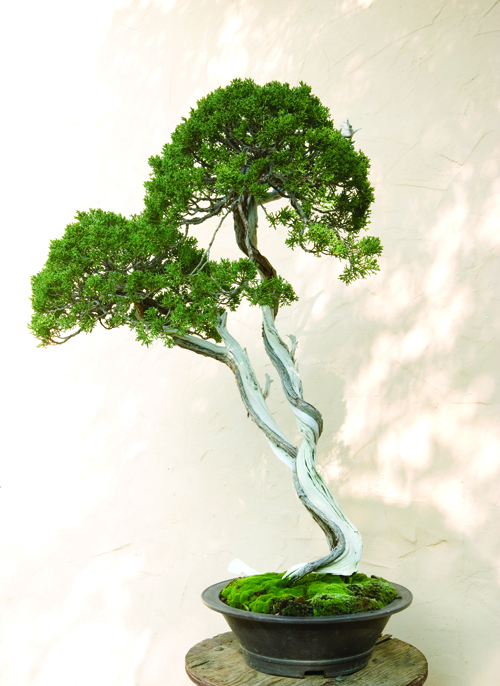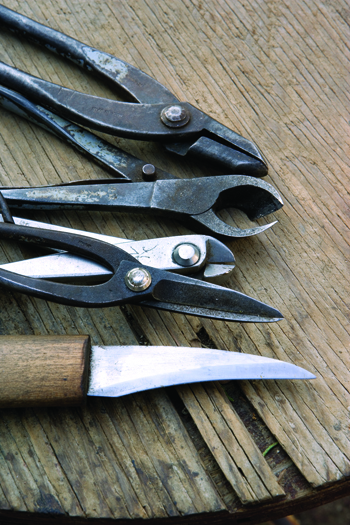
Shimpaku foliage grafted onto a California juniper by Roy Nagatoshi. All of the photos in this post are by Dale Berman. They originally appeared in Bonsai Today issue 108 in an article by Marcus Juniel.
Shimpaku foliage on California junipers
California juniper foliage is heavy and somewhat coarse (I think it looks fine on native stock, but Shimpaku foliage is beautiful and looks even better) and many bonsai artist opt to graft on Shimpaku foliage.
 Approach graft. The Shimpaku (scion) still has it roots in soil when it is joined with the stock. Once the graft has taken, it is cut off from its roots in a place and way that best hides the graft so that no (or almost no) traces of the procedure show. How this is done is a big part of the skill involved in grafting bonsai. This sketch and the one below are also from Bonsai Today issue 108.
Approach graft. The Shimpaku (scion) still has it roots in soil when it is joined with the stock. Once the graft has taken, it is cut off from its roots in a place and way that best hides the graft so that no (or almost no) traces of the procedure show. How this is done is a big part of the skill involved in grafting bonsai. This sketch and the one below are also from Bonsai Today issue 108.

One of Roy’s approach grafts in process. The top of the small Shimpaku in the plastic pot is being grafted onto a large California juniper. When the graft has taken, the part of the Shimpaku below the graft will be removed. It will still be alive and can be grown on for future use as a bonsai or as another scion.
Roy Nagatoshi
I first met Roy Nagatoshi sometime in the 1980 at he and his father’s (Mr Shigeru Nagatoshi) Fuji Bonsai Nursery in Sylmar, California (home of row after row of some of the most massive bonsai you’ll ever see). At the time Mr Nagatoshi senior was still actively running things and Roy seemed to be keeping a fairly low profile. Later, when I visited a couple times in the 90s, things were shifting. Roy was clearly in charge, and his father seemed to be stepping back (Shigeru Nagatoshi died in 2000). Now Roy is fully in charge and as his skills continue to develop, so does his fame; both as a preeminent bonsai artist as as a popular bonsai teacher.

Whip graft (also called tongue or splice graft). Unlike the approach graft, the scion doesn’t have roots to support it while the graft is taking, so you need to provide humidity to keep it alive. A humid greenhouse helps, but the most common method is to use a plastic sleeve with a damp medium (eg sphagnum) inside.

Some tools Roy uses for grafting. Photo by Dale Berman.
Shimpaku foliage on San Jose junipers
Grafting Master Mas Ishii first introduced me to grafting Shimpaku foliage onto San Jose juniper stock. He said that San Jose stock grows better than Shimpuku in North America (or at least under his local conditions – his nursery Chikugo-en is in Los Angeles), but that Shimpaku foliage is much more beautiful (and touchable) than San Jose foliage, and is easy to graft. For more on this topic and Mas Ishii, there’s and excellent article by Lew Buller in Bonsai Today issue 75 (Lew is the author of Saikei and Art; the only English language Saikei bonsai book).
I am fortunate to live near to Roy Nagatoshi’s Fuji Bonsai Nursery in Sylmar, CA. One can see the results of Mr. Nagatoshi’s grafting techniques on a large number of juniper bonsai and yamadori. Simply amazing and beautiful. I recommend a visit to Fuji Bonsai Nursery for any bonsai afficionado. You won’t regret it.
Thanks Aarin,
Your blog is looking good.